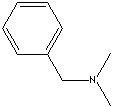PRODUCT IDENTIFICATION

CLASSIFICATION
Amine
EXTRA NOTES
Flammable. Harmful by inhalation, in contact with skin and if
swallowed. Causes burns. Harmful to aquatic organisms, may cause long-term adverse effects in the aquatic environment. Corrosive.
PHYSICAL AND CHEMICAL PROPERTIES
0.92
54
EXTERNAL LINKS & GENERAL DESCRIPTION
Wikipedia Linking - Dimethylbenzylamine
Google Scholar Search - N,N'-Dimethylbenzylamine
Drug Information Portal (U.S. National Library of Medicine) - N,N'-Dimethylbenzylamine
PubChem Compound Summary - N,N'-Dimethylbenzylamine
http://www.ebi.ac.uk/chebi/ - N,N'-Dimethylbenzylamine
http://www.ncbi.nlm.nih.gov/ - N,N'-Dimethylbenzylamine
Local:
Catalyst
for Polyurethane Foams, U.V.-Curing of Styrene, Polymerisation
of Glycolic Acid Lactide and Polyester Products. An
amine accelerator for polymerization of epoxy resins.
APPEARANCE
MOISTURE
HAZARD OVERVIEW
Combustible Liquid, Target Organ Effect, Toxic by ingestion, Harmful by skin absorption., Corrosive. Target Organs:Central nervous system.
GHS
PICTOGRAMS



HAZARD STATEMENTS
H226
Flammable liquid and vapour.
H301 Toxic if swallowed.
H312
+ H332 Harmful in contact with skin or if inhaled
H314 Causes
severe skin burns and eye damage.
H401 Toxic to aquatic life.
PRECAUTIONARY STATEMENTS
P280
Wear protective gloves/ eye protection/ face protection.
P305
+ P351 + P338 IF IN EYES: Rinse cautiously with water for several
minutes. Remove contact lenses, if present and easy to do. Continue
rinsing.
P310 Immediately call a POISON CENTER or doctor/ physician.
![]() C
Corrosive
C
Corrosive
RISK PHRASES
10
Flammable.
20/21/22 Harmful by inhalation, in contact
with skin and if swallowed.
34 Causes burns.
52/53 Harmful
to aquatic organisms, may cause long-term adverse effects in the
aquatic environment.
SAFETY PHRASES
26
In case of contact with eyes, rinse immediately with plenty
of water and seek medical advice.
36 Wear suitable protective
clothing.
45 In case of accident or if you feel unwell,
seek medical advice immediately (show the label where possible).
61
Avoid release to the environment. Refer to special instructions
/ safety data sheets.